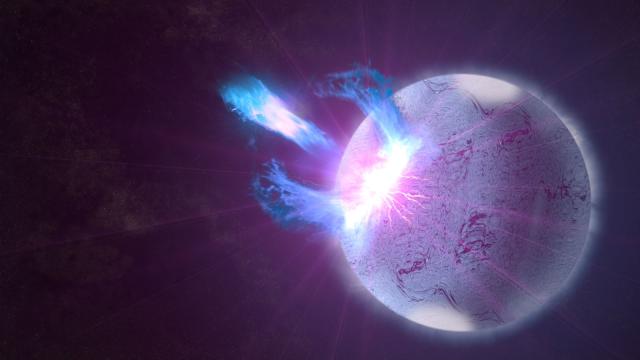In early 2009, NASA’s Fermi Gamma-ray Space Telescope observed an unprecedented solar storm emanating from a distant neutron star with gigantic columns of magnetised flares stretching thousands of kilometres into space — only the third time such an eruption had been observed. Five years later, NASA boffins think they have figured out what’s triggered it.
Neutron stars are the most dense, most magnetic, and fastest spinning directly-observable objects in the known universe. They are the remnants of giant dead suns, the leftovers of supernovas, rapidly spinning masses covered in a crust held together by their own magnetic fields. These celestial bodies can pack the mass of 500,000 Earths into an area the size of Manhattan with magnetic fields trillions of times stronger than our own. But they’re nothing compared to magnetars, a super-rare subset of neutron stars (out of the quintillions of stars, we’ve only managed to find 23 of these), which exhibit magnetic fields 1000 times stronger than regular neutron stars.
It was a magnetar in the Norma constellation some 15,000 light-years away that the Fermi observed. It erupted for seven full months, from October 2008 to April 2009, its largest explosions producing in minutes an amount of energy equivalent what our Sun puts out in two decades. In addition, these major blow ups were accompanied by hundreds of smaller “bursts” over that same time period, much like a terrestrial earthquake and its inevitable aftershocks. Effectively, the Fermi satellite observed this magnetar oscillating like a bell after each eruption.
And for a while, this phenomenon had NASA at a loss as the existing analysis methods were better suited for investigating singular data sources with very little ambient “noise” but the data the satellite returned was nowhere near that fidelity. As University of Amsterdam researcher Daniela Huppenkothen explained in a press release, it was the difference between observing a pond’s ripples after throwing in a single stone and analysing waves in the North Sea during a storm.
In fact, the team had to develop an entirely new technique to make sense of the Fermi satellite data. Their results were published in the June issue of The Astrophsyics Journal. Huppenkothen expounded on those findings at a symposium earlier this week. “We think these are likely twisting oscillations of the star where the crust and the core, bound by the super-strong magnetic field, are vibrating together,” she explained. “We also found, in a single burst, an oscillation at a frequency never seen before and which we still do not understand.”
Researchers have barely scratched the surface of this data but it’s already generated a number of new insights into how neutron stars behave. And since their magnetic fields and massive high energy outputs can’t even be approached in a lab setting, these observations could finally help theoretical astrophysicists figure out what’s going on under a neutron star’s crust. [NASA]
